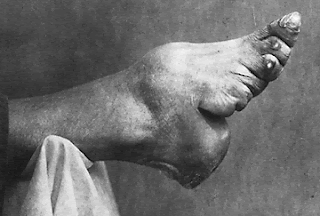The world is not new to brutality enforced on women– right from the gory practice of Sati and Jauhar, to foot binding and genital mutilation which continues to date. The ancient Chinese practise of foot binding or lotus feet began way back in the Tang Dynasty when the court dancer Yaoniang and other Turkic dancers performed in their court during the 10th Century C.E. Infact, the first-ever mention of lotus feet is from 937 and 975 C.E in the Tang Court at Nanking. However, during the Song Dynasty, this practise became popular and a fashion trend.
Lotus feet or the practice of foot binding is an ancient, barbaric practise wherein, the feet of young girls in China were bent to modify their shape. Many people wonder why this practice began and why it continued. But the Chinese believed that the smaller a girls’ feet, the more woman-like and dainty she is. Having smaller feet also increased girls’ chances of marriage. Slowly, small feet became a status symbol for women in aristocratic circles.
Lotus, Silver and Iron Feet

Image Source: https://www.pinterest.com.au/pin/584482857875887384/
Having small feet in China was very similar to having a tiny waist in England. Infact, for families, their daughter’s tiny feet were like currency and most grooms looked out for girls having the tiniest feet, with the most desirable being three-inch feet. These were called ‘lotus feet’. If you had feet that measured four-inches, they would be called ‘Silver Feet’. Feet that were five inches or longer were looked down upon and called ‘Iron Feet’. Girls with iron feet had very meek chances of getting a good groom.
To give you more perspective, a foot measuring 22 inches today translates into UK size 3! We can only imagine what feet measuring three-, four- or five-inches really were for adult, full-grown women.
How Was it Done?

Image Source: http://bittrsweeet.blogspot.com/2007/09/lotus-feet.html
A practice that peaked during the Qing Dynasty, girls as young as 5 or 6 years-old underwent a very painful procedure to grow their feet ‘small’.
Here’s a sneak peek into how a foot binding process was done:
- An auspicious day was chosen by the elders in the family for the foot binding process.
- On the decided day, prayers were offered to the Tiny-Footed Maiden Goddess and the Buddhist figure of Guanyin (a Bodhisattva believed to be the protector and well-wisher of women).
- The older women in the family along with the foot binder then began the process of foot binding.
- First, the feet were soaked in warm water that contained herbs and blood from other animals to soften them as softened feet were easy to bind.
- Next, the last four toes were curled towards the sole of the foot with great force and the big toe was bent over these curled toes.
- A binding cloth was used to tightly bind these toes and the tightening was increased in later stages.
- The toes and the arch of each foot were broken with force and tightened with the binding cloth to tighten the feet and allow them to grow in that fashion.
- This foot binding process lasted from several days up to around two months.
Medical Consequences of the Practise

Image Source: https://www.ancient.eu/image/7335/the-effects-of-foot-binding-on-the-foot-bones/
One doesn’t really need a medical degree to understand that the process and practise of foot binding had a long-term impact on the girls’ life and caused several health complications and disabilities.
Some of the common health problems associated with this barbaric practise include:
- Infections were the most common complication of this practise as proper infection control and antibiotics were not available back in the day.
- Bound feet impacted a girls’ ability to walk, balance and maintain her posture, and this caused a forward curvature of the lumbar vertebrae.
- Girls often complained of pelvic pain as they struggled to balance themselves on their small feet.
- Stooped posture, restricted bone growth and overall development was significantly impacted.
- Since bending, squatting and balancing were difficult, women often ended up with accidents, breaking their hip joints.
- Increased risk of crooked toes and feet gave rise to foot deformities.
Another shocking practise that was followed alongside foot binding was to put sharp glass pieces and shards inside their bound feet to purposely cause an infection to one or more toes. This gave them an opportunity to remove these gangrenous toes, making their feet appear smaller and cuter.
(Un)Wrapping it Up!
The standards of beauty have always been unnecessarily created for women – throughout generations, races, classes and castes all over the world. Though we have progressed today, it is saddening to see such practises, from the bygone era, being relevant in many small pockets even today.
What started as a ‘sign of beauty’ actually led to generations of women with permanent deformities and health complications. The practise of foot binding came under the global scanner when missionaries to China pointed out the cruelty of the practice. Foot binding was outlawed in 1912 after the Nationalist revolution in the year 1911. However, the practice found its end only after China became the People’s Republic of China in 1949, after having existed for nearly a millennium.









